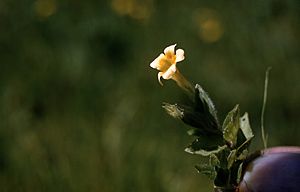Muskflower facts for kids
Erythranthe moschata is a cool plant often called muskflower or musk monkeyflower. It used to be known as Mimulus moschatus. This plant is special because it once had a strong, musky smell that mysteriously disappeared!
Quick facts for kids Muskflower |
|
|---|---|
 |
|
| Scientific classification | |
| Genus: |
Erythranthe
|
| Species: |
moschata
|
Where to Find Muskflower
This plant naturally grows in western North America. You can find it from British Columbia down to California and across to the Rocky Mountains. It likes places that are a bit wet and shady, like mountains, forests, and chaparral areas.
It also grows in eastern North America. Sometimes it's native there, and sometimes it's an introduced plant that arrived from somewhere else. You can even find it growing wild in places like Chile and parts of Europe, including England and Finland. This happened after it escaped from gardens where people were growing it.
What Does Muskflower Look Like?
The muskflower is a perennial herb. This means it lives for more than two years and doesn't have a woody stem like a tree. It grows from underground stems called rhizomes. The plant can be smooth or hairy, and sometimes it feels a bit slimy. It usually has a musky smell, though this is part of a big mystery we'll talk about soon!
The plant's appearance can change a lot. Its stem can lie flat on the ground or stand upright, growing up to 30 centimeters (about 12 inches) long. Its leaves grow in pairs opposite each other on the stem. They are mostly oval-shaped and can be up to 6 centimeters (about 2.4 inches) long.
The flowers are yellow and shaped like a tube. The tube is only a few millimeters wide at the bottom but gets wider at the top, where it opens into several lobes. Each flower can be up to 2.6 centimeters (about 1 inch) long.
The Mystery of the Missing Scent
The Erythranthe moschata was very popular in Victorian times. People loved to grow it in their gardens because it had a strong, pleasant musky smell. But then, something strange happened. Around the year 1913, almost all the cultivated plants, and even wild ones, seemed to lose their strong scent at the same time!
A gardener named Thomas Wilkinson noticed this change around 1898. He said his plants started to smell "rank" instead of musky. Years later, he saw that the plants being sold had no scent at all.
Many people wondered why this happened. Some thought the original strong scent was a rare genetic trait that got lost over time. Others suggested changes in the climate, or even that humans had somehow lost the ability to smell it. One idea was that the scented plants were all clones from a single special plant, and they were later replaced by unscented plants from different seeds.
Interestingly, when the plant was first described in 1826 by David Douglas, he didn't mention any strong musk scent in his notes. This makes the mystery even deeper! Even though many plants lost their scent, some reports in the 1920s and 1930s claimed that strongly scented muskflowers were still found in the wild, like on Texada Island in British Columbia. The mystery of the missing scent continues to puzzle botanists even today.

